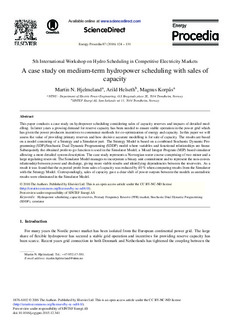A Case Study on Medium-Term Hydropower Scheduling with Sales of Capacity
Peer reviewed, Journal article
Permanent lenke
http://hdl.handle.net/11250/2378573Utgivelsesdato
2016Metadata
Vis full innførselSamlinger
- Institutt for elkraftteknikk [2457]
- Publikasjoner fra CRIStin - NTNU [37963]
Sammendrag
This paper conducts a case study on hydropower scheduling considering sales of capacity reserves and impacts of detailed mod-elling. In latter years a growing demand for reserve capacity has been needed to ensure stable operation in the power grid which has given the power producers incentives to commence methods for co-optimization of energy and capacity. In this paper we will assess the value of providing primary reserves and how decisive accurate modelling is for sale of capacity. The results are based on a model consisting of a Strategy and a Simulator part. The Strategy Model is based on a combined Stochastic Dynamic Pro-gramming (SDP)/Stochastic Dual Dynamic Programming (SDDP) model where variables and functional relationships are linear. Subsequently the obtained profit-to-go function is used in the Simulator Model; a Mixed Integer Program (MIP) based simulator allowing a more detailed system description. The case study represents a Norwegian water course comprising of two minor and a large regulating reservoir. The Simulator Model manages to incorporate a binary unit commitment and to represent the non-convex relationship between power and discharge, giving more viable results and identifying dependencies between the reservoirs. As a result it was found that the expected profit from sales of capacity was reduced by 40% when comparing results from the Simulator with the Strategy Model. Correspondingly, sales of capacity gave a clear shift of power outputs between the models as unrealistic results were eliminated in the Simulator Model.
